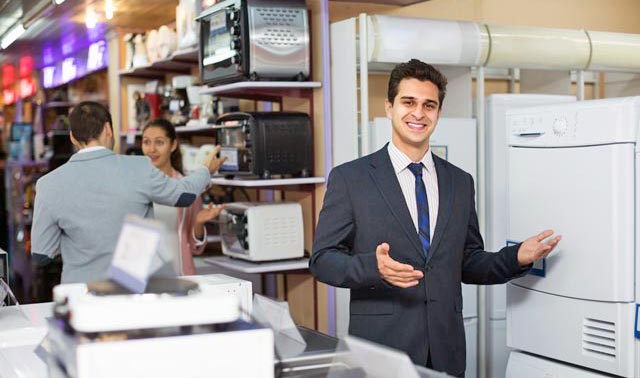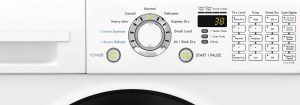Unlock the secrets of efficiency, convenience, and care for your fabrics with our comprehensive guide to tumble dryers! From understanding the different types and their functionalities to expert tips on maximizing energy efficiency, this article has everything you need to know about tumble dryers.
What are the 3 main types of tumble dryers?
The three main types of tumble dryers are vented dryers, condenser dryers, and heat pump dryers.
- Vented tumble dryers expel hot and moist air generated during the drying process through a hose or vent that leads outside.
- Condenser dryers collect moisture from the clothes in a container or condenser unit. The condensed water is either collected in a reservoir that needs to be emptied manually or pumped out through a hose.
- Heat pump dryers are the most energy-efficient among the three types. They use a heat exchanger to recycle and reuse the hot air generated during the drying process, making them more energy-efficient than traditional vented or condenser dryers.
Each type has its advantages and considerations, and the choice often depends on factors such as energy efficiency, installation requirements, and budget. Heat pump dryers are typically more expensive upfront, but they can save on energy costs over the long term.
Is there such a thing as a gas tumble dryer?
Yes, although they are not as common as electric tumble dryers. Gas tumble dryers use natural gas or propane as a fuel source to generate heat for drying clothes.
What size tumble dryer do I need?
The size of tumble dryer you need depends on various factors, including the capacity of the dryer and your laundry needs. As a general guideline:
- Small households (1-2 people): A dryer with a capacity of 4-7 kg may be sufficient.
- Medium households (3-4 people): Consider a dryer with a capacity of 7-9 kg.
- Larger households (5 or more people): Opt for a dryer with a capacity of 9 kg or more.
Do tumble dryers use a lot of electricity?
Tumble dryers can consume a significant amount of electricity, and their energy usage depends on factors such as the dryer’s capacity, energy efficiency rating, and usage patterns. In general, tumble dryers are among the more energy-intensive appliances in a household.
When purchasing a tumble dryer, checking the energy label and selecting a model with a higher energy efficiency rating can help reduce its impact on electricity consumption.
How long is a tumble dryer cycle?
The duration of a tumble dryer cycle can vary depending on several factors, including the type of dryer, the size and type of load, the chosen drying settings, and the efficiency of the dryer itself. Here are some general guidelines:
- Vented Tumble Dryers: Typically, vented dryers have shorter drying times compared to condenser and heat pump dryers. A cycle in a vented dryer might last anywhere from 30 minutes to an hour or more, depending on the factors mentioned above.
- Condenser Tumble Dryers: Condenser dryers generally have longer drying times than vented dryers. The cycle duration can range from 45 minutes to over an hour.
- Heat Pump Tumble Dryers: Heat pump dryers are known for their energy efficiency but often have longer drying times. A cycle in a heat pump dryer can last anywhere from 1 to 2 hours or more.
Keep in mind that the drying time can be influenced by the moisture content of the clothes and the specific features of the dryer, such as sensor technology.
Which uses more electricity vented or condenser tumble dryer?
In general, condenser tumble dryers tend to use more electricity compared to vented tumble dryers.
What is the life expectancy of a tumble dryer?
On average, a well-maintained and high-quality tumble dryer can last between 10 to 15 years.
Regular maintenance, such as cleaning the lint filter, checking and cleaning the venting system, and addressing any issues promptly, can contribute to a longer lifespan.
Do condenser dryers make the room damp?
Condenser tumble dryers do release moisture into the air during the drying process, but they are designed to manage it within the machine rather than releasing it into the room. The moisture is collected in a container or reservoir within the dryer, or it may be pumped out through a hose, depending on the dryer’s design.
However, if the condenser dryer is not properly maintained, such as emptying the water container or ensuring that the drainage system is functioning correctly, excess moisture could potentially be released into the room. Additionally, if the laundry room or the space where the dryer is located is not well-ventilated, there is a chance that some humidity could be introduced into the surrounding air.
What are the disadvantages of a heat pump tumble dryer?
While heat pump tumble dryers are known for their energy efficiency, there are some disadvantages and considerations to keep in mind. Heat pump tumble dryers tend to have a higher initial purchase price compared to traditional vented or condenser dryers. Additionally, heat pump dryers typically take longer to dry clothes compared to vented or condenser dryers.
Can tumble dryers cause mould?
Tumble dryers themselves do not cause mould directly. However, improper use or maintenance of a tumble dryer can contribute to conditions that favour mould growth.
If a vented tumble dryer is not properly vented, or if the condenser in a condenser dryer is not functioning correctly, excess moisture may be released into the laundry area. Excessive moisture can create a damp environment conducive to mould growth.
How likely is a dryer to start a fire?
One of the primary fire risks associated with dryers is the accumulation of lint. Lint is highly flammable, and if it builds up in the dryer’s venting system or around the heating element, it can pose a fire hazard. Regularly cleaning the lint filter and ensuring proper venting can help prevent lint-related fires.
Avoid running the dryer when you are away from home or while you are asleep. This allows you to respond quickly to any issues that may arise.
Can fleas survive the tumble dryer
The high temperatures reached in the dryer can be effective in eliminating fleas, their eggs, and larvae. Ensure that the items spend enough time in the dryer to expose the fleas and their eggs to the heat thoroughly.








